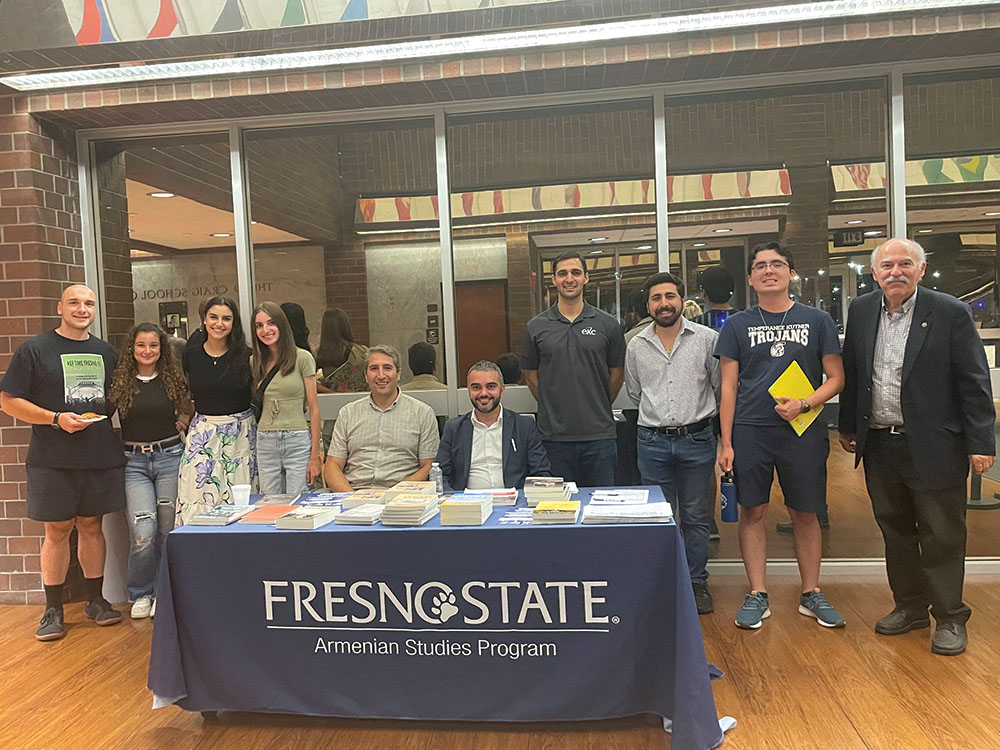
Photo: Natalie Agazarian
Rachel Yepremian
Staff Writer
On Friday, September 27, Dr. Simon Maghakyan, Kazan Visiting Professor in Armenian Studies, held the first of his three-part lecture series entitled, “The Past of the Past: Armenian Heritage in Ottoman and Republican Turkey.” The Kazan Visiting Professorship was established in 2001 through an endowment by Henry Khanzadian Kazan and the first visiting professor was Dr. Richard Hovannisian.
Dr. Maghakyan is a community scholar at the University of Denver’s Korbel School of International Studies and Postdoctoral fellow at the University of Oxford who recently completed his doctorate degree from Cranfield University in Defense and Security.
Dr. Maghakyan’s lecture discussed historical Armenia’s most prominent monasteries, and especially the St. Garabed Monastery of Mush, which is located in present-day Turkey. The Monastery has been a historic pilgrimage site, revered by Armenians. An Armenian prayer of protection and guardianship invoking the monastery has become common for devout Armenians.
The lives of countless Armenian soldiers were tragically taken in the battle in defense of Artsakh (Nagorno-Karabagh). September 27 was the anniversary marking the ethnic cleansing of Armenians by Azerbaijan. These fallen soldiers fell in an act of bravery, putting their lives on the line and at stake for their country. Dr. Maghakyan gave an example of a soldier who had lost his life in the battle, and who had been carrying the prayer of St. Garabed with him.
A significant portion of Armenia’s historical landscape, churches, and sacred sites are now found in the modern Republic of Turkey. Dr. Maghakyan cited the theoretical researchers of authors like David Lowenthal and Laurajane Smith, who have influenced academic literature on heritage, including the latter’s construction, uses, and abuses. There are different types of heritage, both tangible like the examples previously mentioned and also intangible, like songs, language, and traditions.
Heritage can be thought of in the sense of a verb, as a process. Not only is heritage a process, but it is a process extremely important to a culture and nation’s growth and ability to prosper. This leads to an explanation of why demoralization is the first target when a nation is attacked, followed by economic motivation to plunder and securitization – a process of imagining cultural sites as existential threats. Prior to the Armenian Genocide in 1915, Armenians experienced the Adana Massacres of 1909 and the Hamidian Massacres of 1895, which included numerous acts of cultural destruction.
Dr. Maghakyan is currently teaching a course on “Armenian Heritage and Conflict” at Fresno State. He recently asked his students what heritage means to them and what it looks like in their personal lives. The top answer was culture, followed by identity, history, family, and symbols. One student mentioned that heritage is collective memory. Some memories are material: a number of movable cultural properties survived the Armenian Genocide: carpets, copper trays, and manuscripts.
Dr. Maghakyan was the first in his extended family to visit the city of Urfa, now located in Turkey. The largest cathedral in that area was destroyed during the Hamidian Massacres through fire, and once again during the Armenian Genocide. The cathedral was finally converted to a mosque. In the area of Nakhichevan, now a region of Azerbaijan, Armenians are not allowed to visit, and are only able to get as near as the Iranian border. Only from a distance are Armenians able to see the destruction that occurred in the Armenian cemetery in 2005, which Dr. Maghakyan has documented for two decades.
“This is not new. We have governments that have the ability to destroy culture in ways that were not imaginable in the past, where they can monitor terrains, use theology, and completely flatten history,” said Dr. Maghakyan.
The Tabula Chorographica Armenica, dating from the late 1600s, is one of the world’s largest maps, marking the location of almost 800 Armenian churches throughout the Ottoman and Persian empires. Churches and monasteries were targeted more so since 1895 when the Hamidian Massacres began. A list published in 1897 showed the statistics of over 2,500 towns and villages that were looted and destroyed during that time period, 568 churches, 328 converted churches, and 77 destroyed monasteries.
“Churches were not just places of worship, places of ceremony like wedding or marriage, they were places of learning,” said Dr. Maghakyan.
Dr. Maghakyan showed the audience different images of monasteries, monuments, and moments that are precious to Armenian heritage. Waves of destruction in Armenia and toward Armenian culture over time have taken a toll on the nation. As Armenia continues to fight to stay alive as a prospering nation, she continues to fight against neglect.
Dr. Maghakyan’s lecture is archived on the Armenian Studies YouTube channel: bit.ly/armenianstudiesyoutube.
Dr. Maghakyan will give a second presentation entitled “The Present of the Past: The State of Armenian Heritage in Turkey,” on Friday, October 11.
 Hye Sharzhoom Armenian Action
Hye Sharzhoom Armenian Action